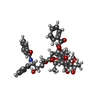+Search query
-Structure paper
| Title | The inner junction complex of the cilia is an interaction hub that involves tubulin post-translational modifications. |
|---|---|
| Journal, issue, pages | Elife, Vol. 9, Year 2020 |
| Publish date | Jan 17, 2020 |
 Authors Authors | Ahmad Abdelzaher Zaki Khalifa / Muneyoshi Ichikawa / Daniel Dai / Shintaroh Kubo / Corbin Steven Black / Katya Peri / Thomas S McAlear / Simon Veyron / Shun Kai Yang / Javier Vargas / Susanne Bechstedt / Jean-François Trempe / Khanh Huy Bui /   |
| PubMed Abstract | Microtubules are cytoskeletal structures involved in stability, transport and organization in the cell. The building blocks, the α- and β-tubulin heterodimers, form protofilaments that associate ...Microtubules are cytoskeletal structures involved in stability, transport and organization in the cell. The building blocks, the α- and β-tubulin heterodimers, form protofilaments that associate laterally into the hollow microtubule. Microtubule also exists as highly stable doublet microtubules in the cilia where stability is needed for ciliary beating and function. The doublet microtubule maintains its stability through interactions at its inner and outer junctions where its A- and B-tubules meet. Here, using cryo-electron microscopy, bioinformatics and mass spectrometry of the doublets of and , we identified two new inner junction proteins, FAP276 and FAP106, and an inner junction-associated protein, FAP126, thus presenting the complete answer to the inner junction identity and localization. Our structural study of the doublets shows that the inner junction serves as an interaction hub that involves tubulin post-translational modifications. These interactions contribute to the stability of the doublet and hence, normal ciliary motility. |
 External links External links |  Elife / Elife /  PubMed:31951202 / PubMed:31951202 /  PubMed Central PubMed Central |
| Methods | EM (single particle) |
| Resolution | 3.6 - 4.57 Å |
| Structure data | EMDB-20855: 48-nm repeat unit of the doublet microtubule from Chlamydomonas reinhardtii  EMDB-20856: EMDB-20858, PDB-6ve7: |
| Chemicals |  ChemComp-GTP:  ChemComp-MG:  ChemComp-GDP:  ChemComp-TA1: |
| Source |
|
 Keywords Keywords | STRUCTURAL PROTEIN / cilia / doublet / axoneme / microtubule inner protein |
 Movie
Movie Controller
Controller Structure viewers
Structure viewers About Yorodumi Papers
About Yorodumi Papers








